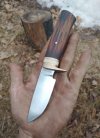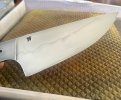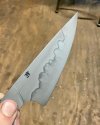- Joined
- Aug 17, 2020
- Messages
- 260
Hello again everyone! I have a few hamon related questions that I was curious about that I hope might be able to be answered by you guys.
So, I've been looking at a lot of different makers hamons and trying to understand their technique, specifically on thin kitchen knives. How do you go about creating a hamon on large thin kitchen knives without getting warps? From what I understand in order to bring out a hamon like on shallow hardening steels like 1095 or W2 you need to grind your bevels to about 70% complete and then go about applying your clay to the bevel in the pattern that you wish to see. Correct me if I am wrong here but is it possible to grind through your hamon if you don't grind your bevels before applying your clay? For example, if one was using 0.100 stock or thinner wouldn't the chance of warpage be fairly high if you had your bevel 70% ground?
Since I don't have the temp control to use 1095, W2, or preferable hamon compatible steels do any heat treating services provide the option to add a hamon? If so, do they just create a random hamon or do you have to draw out your hamon on your blade or something before sending it off to ht? This brings me back to my first question but should I grind my bevels before sending them off to ht to have a hamon added?
This is a metalurgy question I guess but why do steels like 1084 with higher manganese content don't provide a hamon like W2? What's the deal with the manganese?
So, I've been looking at a lot of different makers hamons and trying to understand their technique, specifically on thin kitchen knives. How do you go about creating a hamon on large thin kitchen knives without getting warps? From what I understand in order to bring out a hamon like on shallow hardening steels like 1095 or W2 you need to grind your bevels to about 70% complete and then go about applying your clay to the bevel in the pattern that you wish to see. Correct me if I am wrong here but is it possible to grind through your hamon if you don't grind your bevels before applying your clay? For example, if one was using 0.100 stock or thinner wouldn't the chance of warpage be fairly high if you had your bevel 70% ground?
Since I don't have the temp control to use 1095, W2, or preferable hamon compatible steels do any heat treating services provide the option to add a hamon? If so, do they just create a random hamon or do you have to draw out your hamon on your blade or something before sending it off to ht? This brings me back to my first question but should I grind my bevels before sending them off to ht to have a hamon added?
This is a metalurgy question I guess but why do steels like 1084 with higher manganese content don't provide a hamon like W2? What's the deal with the manganese?





